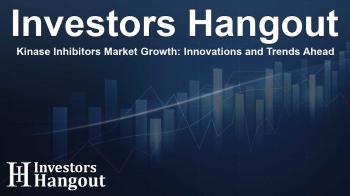Kinase Inhibitors Market Growth: Innovations and Trends Ahead

Overview of the Kinase Inhibitors Market Dynamics
The global kinase inhibitors market is experiencing substantial growth, propelled by significant advancements in targeted therapies and a rising incidence of cancer and chronic diseases. Latest evaluations reveal that the market was valued at USD 58 billion in recent assessments and is expected to surge to approximately USD 90 billion by the end of the next decade. This impressive growth rate underscores a remarkable compound annual growth rate (CAGR) of 3.9% over the forecast period.
Driving Forces Behind Market Expansion
Several factors contribute to the dynamic expansion of the kinase inhibitors market. One of the most critical drivers is the rising demand for personalized medicine, alongside an increasing focus on preventive healthcare strategies aimed at enhancing patient outcomes.
Key Players Leading the Innovation
A healthy competitive landscape characterizes the kinase inhibitors market, with numerous leading pharmaceutical companies at the forefront of innovation. Notable industry players such as Boehringer Ingelheim, Novartis, AstraZeneca, and Pfizer are instrumental in this evolution, focusing their efforts on the development of novel therapies and strategic collaborations.
Technological Advancements Fueling Growth
The advancement in molecular biology has facilitated the emergence of next-generation kinase inhibitors. These innovations are not only enhancing the efficacy and safety profiles of therapies but are also fostering the development of highly selective treatment options that cater to individual patient needs.
Healthcare Trends Impacting Kinase Inhibitors
As cancer prevalence continues to increase globally, the demand for effective treatment options rises commensurately. Kinase inhibitors play a pivotal role in oncology by targeting specific cellular processes to inhibit the growth of cancer cells.
Emerging Focus on Combination Therapies
The evolving approach towards treatment is also seeing a shift towards combination therapies, where kinase inhibitors are administered alongside other cancer modalities, such as immunotherapies. This integrated strategy aims to improve therapeutic efficacy and manage resistance.
Personalized Medicine Takes Center Stage
In recent years, the trend towards personalized medicine has gained remarkable traction. Treatments are increasingly designed according to individual genetic profiles, enhancing the success rates of therapies while minimizing potential side effects.
Challenges and Opportunities in the Marketplace
Nevertheless, the kinase inhibitors market faces certain challenges. The existence of drug resistance, particularly due to mutations in target kinases, can complicate treatment protocols. Moreover, off-target effects may lead to adverse side effects, which necessitate ongoing research and stringent clinical trials to optimize therapeutic outcomes.
Regulatory Landscape and Market Accessibility
The regulatory environment is evolving, promoting quicker approvals for innovative treatments, thereby expanding the range of therapeutic options available. Additionally, the patent expirations on established kinase inhibitors are paving the way for affordable generic alternatives, increasing accessibility for patients.
Regional Market Dynamics
The market dynamics across various regions show differing growth trajectories. North America retains its dominance, thanks to advanced healthcare infrastructure and significant R&D investments, while the growing markets in Asia-Pacific are becoming increasingly viable due to rising awareness and healthcare investments.
Future Market Outlook
The future of the kinase inhibitors market remains optimistic. Continued investment in R&D and strategic initiatives by key players are expected to maintain momentum. As companies navigate challenges, they are likely to enhance their competitive position through innovation and collaboration.
In conclusion, the transformative journey of the kinase inhibitors market is anticipated to be shaped by ongoing advances in personalized therapy, strategic partnerships, and a commitment to addressing the nuances of cancer treatment.
Frequently Asked Questions
What is the current value of the kinase inhibitors market?
The current value of the kinase inhibitors market is approximately USD 58 billion.
How fast is the kinase inhibitors market expected to grow?
It is projected to grow at a CAGR of 3.9% and reach around USD 90 billion by 2034.
Who are the key players in the kinase inhibitors market?
Key industry players include Boehringer Ingelheim, Novartis, AstraZeneca, and Pfizer.
What are the main applications of kinase inhibitors?
Primarily, kinase inhibitors are used in oncology to target various forms of cancer.
What challenges does the market face?
The market faces challenges such as drug resistance and potential side effects from off-target actions.
About The Author
Contact Ryan Hughes privately here. Or send an email with ATTN: Ryan Hughes as the subject to contact@investorshangout.com.
About Investors Hangout
Investors Hangout is a leading online stock forum for financial discussion and learning, offering a wide range of free tools and resources. It draws in traders of all levels, who exchange market knowledge, investigate trading tactics, and keep an eye on industry developments in real time. Featuring financial articles, stock message boards, quotes, charts, company profiles, and live news updates. Through cooperative learning and a wealth of informational resources, it helps users from novices creating their first portfolios to experts honing their techniques. Join Investors Hangout today: https://investorshangout.com/
The content of this article is based on factual, publicly available information and does not represent legal, financial, or investment advice. Investors Hangout does not offer financial advice, and the author is not a licensed financial advisor. Consult a qualified advisor before making any financial or investment decisions based on this article. This article should not be considered advice to purchase, sell, or hold any securities or other investments. If any of the material provided here is inaccurate, please contact us for corrections.

